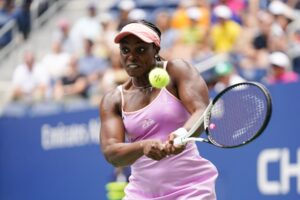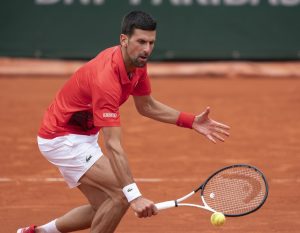When Grigor Dimitrov defeated Roger Federer in the US Open quarterfinal earlier this week, he may have done more than simply reach his first Major semi-final since the 2017 Australian Open. In the process, he might just have shed the most unwanted nickname not only in tennis but arguably in the whole of sport. If he goes on to win the US Open this weekend, he will surely be called “BabyFed” (in almost mocking recognition of the supposed resemblance of his own game to that of the great Swiss) no longer. Instead, it might be Federer himself who acquires an undesired monicker, because his latest crushing disappointment at a Slam could just lead to his being called “DaddyFed”, or, even worse, “Grandad-Fed”.
It is often said that tennis, like almost every other major professional sport, is increasingly a game of numbers, as an ever-expanding amount of statistics and analytics are cited as evidence of the upturn, or decline, in a player’s game. And yet the single most important number of all (and, ironically, the one that is most often dismissed as “just a number”) is a player’s age. Now that Federer is 38, it is undeniably the case that he is no longer what he was even a couple of years ago, when the “late and great” period of his extraordinary career took him to the final three Majors (the 2017 and 2018 Australian Opens, and the 2017 Wimbledon title) of his all-time record haul of 20. And that decline is also borne out by the fact (warning: here’s another stat-attack) that, in losing to Dimitrov this year after succumbing to Australia’s John Millman in the fourth round last year, he has lost in the US Open in successive years to players from outside the world’s top 50.
Now, it must be acknowledged that, unlike Millman, Dimitrov is not remotely the journeyman that his current world ranking of 78 might suggest. The very fact that he was even compared to Federer (albeit unfavourably) was proof of his startling natural ability, as epitomised by that gorgeous single-handed backhand, which is and surely always will be the shot of choice for the true tennis connoisseur. And whatever he achieves from now on in New York, Dimitrov will surely be hurtling back towards the world’s top 20, at least, before the end of the year.
Nevertheless, the fact that Federer lost from two sets to one up against the Bulgarian, who has suffered so many injuries and been in such horrendous form that he has tumbled down the world rankings throughout 2019, was the latest example of his losing, seemingly from a position of strength, to a player he had never lost to before, and in a Major to boot. (For earlier examples, see his loss to Millman in 2018 or his defeat against Kevin Anderson at Wimbledon earlier that year.)
Like the very greatest athletes, who he undoubtedly ranks among, Federer has long appeared capable of defeating not only any opponent on the tennis court but the ultimate opponent for any sportsman (indeed, any human being), namely time itself. Like Ali, Don Bradman, Pele and Tom Brady, he attained dizzying heights of sporting achievement for an incredibly long time. However, as the variation on the old adage has it, “Time wounds all heels”, and in the end even apparently immortal sportsmen and women succumb to injury, or at the very least the gradual decline of their physical abilities.
That was certainly the case against Dimitrov in New York. What was perhaps even more worrying for all of Federer’s fans (the fabled “FedHeds”) than the defeat to the Bulgarian, who is 10 years his junior, was his reaction to it afterwards. Having received treatment to his back late in the match, Federer admitted afterwards, “I felt it the whole time”, and even more remarkably he confessed to being in such discomfort that his only hope was to somehow win the match and then rest up for as long as possible before any semi-final. “It’s just a missed opportunity to some extent that you’re in the lead, you can get through, you have two days off after.” When any athlete, especially an ageing one, admits to looking forward to (or even requiring) rest and recuperation while he is actually still competing, that is undoubtedly a cause for alarm.
So where next for Federer? In the short term, he will surely play on for the rest of the season, including his usual foray to the season-ending ATP Tour Finals at the O2 in London. Then, in the medium to longer term, all the signs are that, even as he is fast approaching 40, he will play on for at least one more full season, particularly as 2020 is an Olympic year and he still apparently craves the Olympic Singles Gold that is the only important title that he has never won. But is that really wise? And beyond that, is there any realistic prospect of his playing on, as has sometimes been suggested (including by Federer himself), into his forties?
In considering Federer’s future options, it is perhaps instructive to consider the fate of previous great male players who, like Federer, have dominated tennis (or at least been very near the top of the game) for a significant period of time. To begin with, we could look at the three fellow legends who watched Federer win what was at the time his record-breaking fifteenth Major at Wimbledon in 2009: Pete Sampras (who held the previous record of 14) retired at the age of 31; Rod Laver may have played on beyond his own 40th birthday in 1979, but his last Major had come at the US Open more than 10 years earlier; and of course Bjorn Borg famously quit the game at the ridiculously early age of 26. Indeed, in the entire history of men’s tennis the only truly great champion who played on for anywhere near as long as Federer is “Big” Bill Tilden, the great American champion from between the two World Wars. However, tennis was not only an amateur sport then but one that in many ways bore no real comparison to the ultra-professional and ultra-physical sport that it has become in the 21st century.
So, Federer, as he is in so many ways, is very much the outlier in men’s tennis, in having won so many Majors (20) over so long a period (the 15 years between Wimbledon 2003 and the 2018 Australian Open). And given that the evidence of his physical decline is surely now irrefutable, why should he play on any longer, rather than retiring soon, or at least within the next calendar year?
The answer, of course, is that for a long time now Federer has not been playing so much against his contemporary opponents as against tennis history itself. He is so determined to at least end his career as the GOAT (Greatest of All Time) of tennis that it is surely not winning another Major per se that now motivates him but rather the thought of protecting or perhaps even extending his record of 20 Grand Slam titles, even as his great rivals – Nadal and Djokovic – come ever closer to catching and then overtaking him.
That prospect is now more realistic than it has ever been before. If Nadal wins in New York this weekend, and as the only Major winner in the last four he is the overwhelming favourite to do so, he will win his 19th Major. And even if he cannot win in Melbourne in January (he has only ever won the Australian Open once, making it by far his least successful Major), he will surely win at least one more French Open before he, too, finally succumbs to injury and bows out.
That is the danger that Federer now faces. If he were to retire now, he would still do so as the GOAT, even if he were soon to be overtaken by Nadal and possibly by Djokovic, too. But if he plays on beyond the next 12 months, there is every chance that even that last triumph will be denied him. That is what makes this very final stage of his fantastical career arguably the most fascinating one of all.
Main Photo:






